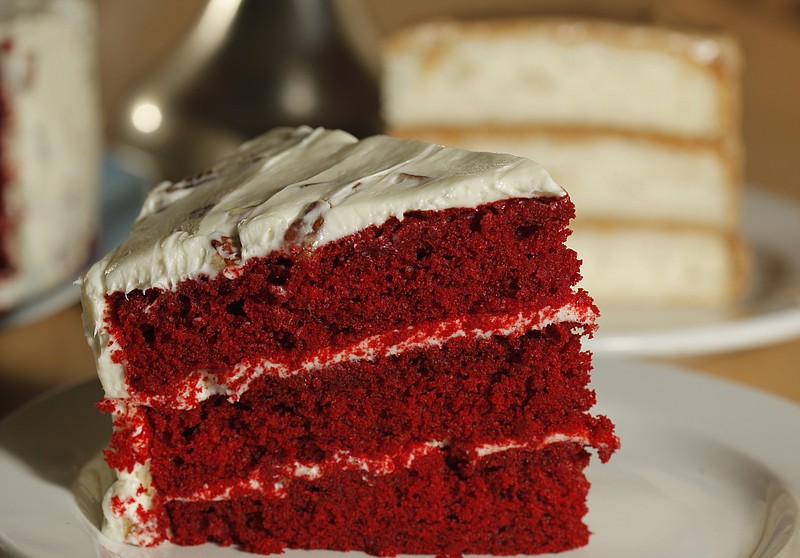TIPS FOR A SUCCESSFUL LAYER CAKE• Dip the spatula in hot water to keep cake crumbs from getting into the icing. This is especially useful for red velvet cakes.• Use heavy pans with 2-inch metal sides.• Measure out the batter for even layers.• Make sure the oven rack is level.• Let the cake cool completely before frosting. You can wrap warm cake layers in plastic and freeze them until needed.• Spread filling a quarter inch to the edge of the cake, not all the way, to prevent oozing.• Don't push down on the layers after you add filling.Sources: From Vanessa Rocchio, Nancy Adams, Rick Adams
Step aside, cupcakes.
Layer cakes are making their way back to the dessert table.
In a recent "Today" show interview, James Oseland, editor-in-chief of Saveur Magazine, counted layer cakes among the top food trends for 2012, describing the marriage of cake, filling and frosting as "the quintessence of sweetness."
"It's nice to see cake no longer relegated to cupcake size but instead rearing up to its full height, its true, towering self," Oseland wrote on "Today's" food blog, titled "Bites."
Indeed, bigger does seem to be better when it comes to layer cakes. Vanessa Rocchio, test kitchen specialist and food stylist at Southern Living Magazine, and Nancy and Rick Adams, owners of Southern Star restaurant, extolled the virtues of a large slice of cake.
"Bigger is better," Rick Adams said. "It's sweeter, and it's tastier."
But then again, the folks at Southern Star never got into the bite-size trend, he said.
"All of our desserts have always been big and ample and Southern."
On Feb. 27, Saveur's associate food editor, Ben Mims, wrote that making a layer cake allows him to feel closer to his estranged mother.
From red velvet cake to 15-layer cakes with boiled chocolate icing, from lemon cheese cake to the Lane cake so famously remembered in Harper Lee's "To Kill a Mockingbird," layer cakes make a bold statement. A filling allows a different flavor than one would be able to acquire with a simple cake and frosting combination. Even cakes layered with the same icing with which they are topped permit a taste of both cake and frosting with each bite.
"[Cakes] were special," said Rocchio of the dessert's origins, "especially pound cakes, and then people began to layer them up with frosting."
The space between cake layers is not limited to frosting. Fruit, gelatin, jam and whipped cream also are found inside many layer cakes. A Lady Baltimore cake, for example, uses a filling that features chopped nuts and dried fruit.
The shining star of Southern Star restaurant is caramel cake -- three layers of white cake alternated with caramel frosting. There have been requests to ship the cake out of state, the Adamses said, but they decline for fear the confection would not maintain its integrity en route.
Their 16-year-old daughter recently tried her hand at a little layer cake -- a nine-layer yellow cake alternated with layers of chocolate icing cooked on the stove.
"I'm from South Georgia," said Nancy Adams, "and that's on everybody's repertoire."
Rocchio said layer cakes have always been associated with special occasions. She makes one each year for her son's birthday, just as one was made for her during her own childhood.
"My entire life, my grandmother made me a cake for my birthday," she said, "so I grew up with cakes. For my 16th birthday, I begged to have a store-bought cake. After that, I decided homemade cakes were really the best."
LEMON CHEESE LAYER CAKE
From The New York Times, adapted from "The Gift of Southern Cooking," by Scott Peacock and Edna Lewis (Knopf, 2003).
For the cake:
31/4 cups cake flour
21/4 teaspoons baking powder
1/4 teaspoon salt
2 cups granulated sugar
1 cup (2 sticks) unsalted butter at room temperature (plus more to grease pan)
8 egg whites
1 cup milk
2 teaspoons vanilla extract
For the lemon curd:
21/4 cups granulated sugar
3/4 cup plus 1 tablespoon fresh lemon juice
3/4 cup (11/2 sticks) unsalted butter, melted
12 egg yolks
3 tablespoons finely grated lemon zest
1/2 teaspoon salt
Heat oven to 350 degrees. Grease three 9-inch cake pans and line with parchment or wax paper. Mix flour, baking powder and salt, and sift onto a piece of wax paper or parchment.
In a large mixing bowl, beat sugar and butter until light and fluffy, scraping sides as needed. Whisk egg whites until well blended but not foamy, and add to batter in 4 batches, making sure each addition is well incorporated.
Add dry ingredients and milk to batter, alternately, in 4 batches, mixing each only until just blended. Mix in vanilla.
Divide batter among 3 pans to eliminate large air bubbles. Bake for about 20 minutes or until cake springs back in center when pressed or a cake tester comes out clean. Let rest for 5 minutes, then remove cake from pans and cool completely on rack.
Meanwhile, make curd: Put all ingredients in a nonreactive saucepan and whisk to blend. Set over medium heat and cook, stirring constantly, until filling thickens and a candy thermometer registers 170 degrees. This can take 10 to 15 minutes. Do not let filling simmer or boil. Remove from heat and pour into a bowl to cool to room temperature.
Place a cake layer on a cake stand or plate and spread 2/3 cup curd on top to the edges. Stack another layer, and continue until all layers have been used. Use remaining curd on top and sides. Filling is somewhat translucent, so layers will be visible through curd on sides. If layers slide while frosting, push 3 or 4 long wooden skewers through them to hold until cake sets. Cake is best left covered at room temperature overnight.
